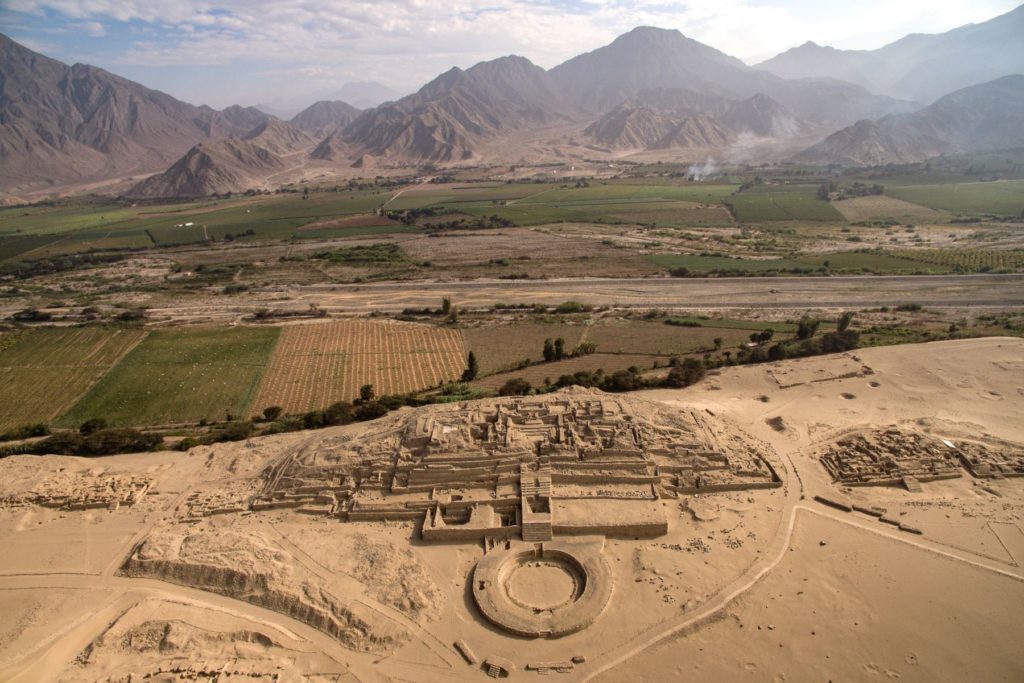Visit 5000-year-old Caral from Lima.
It will take you an hour just to get clear of the urban sprawl of Lima on your way to Caral, along the Panamerican Highway heading north. The journey out of Lima is an adventure in itself as you see the true hustle and bustle of Lima playing out amidst the chaotic transport system.
Once clear of the Peruvian capital, and after driving through the driest place on the planet for another 90 minutes or so, you will get to the turn-off for Caral, just before the town of Barranca. A few kilometers inland down this dusty road and then down a dumpy, dirt track you will arrive at this truly ancient site.
Discovered for the first time in 1905 the site was quickly forgotten again as there were no valuable items to steal, for example, gold or pottery. It was then “re-discovered” in 1994 and in 1996 the first real scientific investigation work began. In 2006 the first official tourists began to arrive at the site and the income generated by such tourism has become extremely important to the continued investigation and preservation of a site where the structures are fragile and open to erosion.
Carbon dating of reed bags that were found shows that Caral existed in 2627 BC, so it predates Machu Picchu and the Inca civilization by 4000 years and is even older than the Egyptian pyramids. It is clearly a very important find, and work is slowly ongoing to restore the large platforms, stone circles, pyramids and living quarters that have been unearthed.

Click here to see photos from the Caral trip made by Gary and friends in October 2015.
Experts have estimated that there could have been over 20,000 people living in the immediate area of the Supe Valley, with Caral being the capital city. The civilization predates the ceramic period explaining why pottery was not found as it has been at many other Peruvian sites, the people in this area would have been dedicated to the domestication of animals and food crops, and also cotton. Some artifacts were found such as 32 flutes made from pelican and animal bones, these instruments were engraved with the figures of birds and monkeys showing that although Caral is located on the Pacific coast, its inhabitants were aware of the animals of the Amazon.
When you arrive at the site it is obvious that authorities are making a concerted effort to impress with a nicely constructed reception area and plenty of historical and visual information available. Tours are done with a guide who may or may not speak English (tours done with us will always have an English-speaking guide with you from Lima), in groups of approximately 15 to 20 people, and you may have to wait until a few people build up before starting. You are not permitted to wander off, even on the set walkways and hence don’t get to walk the whole site, but with a tour of around 90 minutes, this gives you a good overview of the main structures. As you walk around try to imagine what it would have been like all those eons ago to get a more authentic feel. We imagine an area full of people focused on laboring and agriculture; farming, drawing water, building, worshiping, etc.

Archaeologists believe that the people of Caral were religion-focused and the site was primarily a ceremonial center with musical instruments. A depiction of a deity similar to that at Tiwanaku in Bolivia was found here, there are thoughts that this civilization influenced the civilizations that followed it. Caral was only populated for around 500 years and it is believed that it may have been abandoned due to drought. The assumption is that the site was left as people went in search of more fertile land for a better quality of life.
Caral is famed as the most ancient city of the Americas and is a UNESCO World Heritage Site, but is virtually unknown in the face of the Inca citadel of Machu Picchu. We highly recommend a visit and can only imagine that as restoration and research continues it will become increasingly popular as more information becomes available.


